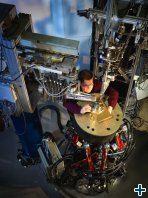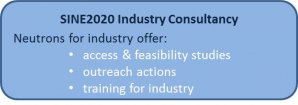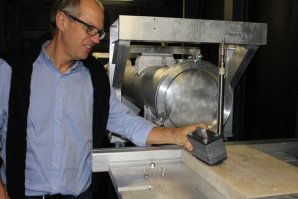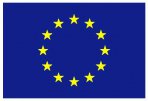Q&A: Enhancing cooperation between industry and neutron facilities
Get to know the main points of action, benefits, and challenges of the SINE2020 Industry Activity.

The stress scanning instrument SALSA at ILL, which is regularly used for industrial studies. © ILL / Artechnique
SINE2020, 13/09/2016
Partner Facilities: HZG, ILL, HZB, TUD, ISIS, LLB, MTA EK, NPI, TUM
The SINE2020 Industry Consultancy initiative aims to strengthen cooperation between European Industry and neutron facilities by offering free test measurements and feasibility studies to companies from the EU.
The coordinator of this initiative is Marc Thiry from the Helmholtz-Zentrum Geesthacht in Germany, who works closely with the Industrial Liaison Officer Caroline Boudou and Jérôme Beaucour from the Institut Laue-Langevin (ILL) in France. Here they explain the main points of action, benefits, and challenges of the SINE2020 Industry Activity.
What are the main points of action of the SINE2020 Industry Consultancy?
We have two main types of actions. The first and most important action is to streamline industrial access to instruments at SINE2020 member facilities to solve specific technical problems a company may have. One of the difficulties is to demonstrate to a company the efficiency of neutron characterisation and convince the company executive it will pay back for their investment in time and money. This is why, thanks to SINE2020, we arrange to demonstrate for free, before any paid service, that neutron characterization techniques can give indeed a relevant answer to the question raised.

The second pillar is to organise outreach actions. Managers and even Engineers are most of the time not familiar at all with neutron techniques. There is a tremendous effort to be made to explain why and how it is possible to easily conduct characterizations with neutron techniques and show how this is a unique tool. So we will develop many communication initiatives to make neutron a reasonably popular engineering technique! This will rely on the following actions: participate in fairs, organise events to explain the potential of neutron characterisation techniques and possibly some specific training actions for engineers.
Could you give some examples where neutrons can be useful for Industry?
For instance, neutrons have the capability to deeply penetrate metals, making it easy to make 2D or 3D images of large objects made of metal or ceramic and to provide a contrast with polymers or any hydrogenated substance (like water). In a real case such as a company producing rails for airplanes needs to understand why some rail wheels are failing, neutrons can reveal whether there are cracks inside or unexpected residual stress over critical areas, which cannot be observed by other means. A number of examples are displayed on our webpage.
How will this activity improve the relation between scientists and Industry?
Given that scientists and Industry sometimes speak “different languages” we deemed it very important to have someone dedicated to the industrial activities for SINE2020. It is difficult for scientists to find the time to do this on the top of their job. Whereas scientists can indeed give support during experiments, they cannot go to fairs, meetings, etc., to talk with industry and plan what can be done. So we hired Caroline Boudou who is now our SINE2020 Industrial Liaison Officer. She has a PhD in Physics and experience in R&D, so she has the expertise to speak both with the engineers at a company and with the scientists at a neutron facility. She can thus make the connection between science and industry.
What are the benefits of taking part of SINE2020?

Dr. Jérôme Beaucour, in charge of Industry Liaison, at the new D50 instrument for industry at ILL.
SINE2020 gives us the possibility to broaden the offer to industry, as this is a collaboration between a number of neutron facilities which are complementary to each other. We can thus improve and extend the quality of the services offered.
Whereas at ILL we offer a number of techniques, if a company needs to use neutron imaging, the best facilities to go are e.g. the Paul Scherrer Institute in Switzerland and FRM II in Germany. At the Budapest Neutron Centre they offer e.g. Neutron Activation Analysis (NAA), which is a technique that can be very useful for industry to analyse the composition of samples in a non-destructive way. So SINE2020 will give advice to industry on the facility that can best answer their needs according to their specific requirements, or find alternative facilities during shut-downs, when a facility is under maintenance or receives an upgrade.
What are the biggest challenges you will face?
The first challenge is to provide a global answer from neutron centres to industrial companies as opposed to work individually as it happened before SINE2020 existed.
Another point is the difficulty to reach out to industrial companies. Companies often are not familiar with neutron facilities and might find the research world complicated. We will work to change that opinion. We are able to propose very professional services and we will take steps to demonstrate that.
Apply for free experiments here .





